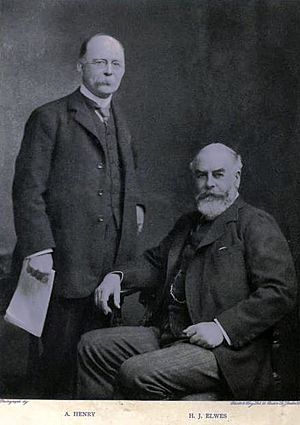Augustine Henry facts for kids

Augustine Henry (born July 2, 1857 – died March 23, 1930) was an amazing Irish plantsman (someone who studies plants) and sinologist (someone who studies China). He is famous for sending over 15,000 dried plant samples, seeds, and 500 live plants to Kew Gardens in the United Kingdom. Many of these plants were new to science! By 1930, he was a well-known expert. He was honored by groups in Belgium, Czechoslovakia, Finland, France, and Poland. In 1929, a special book of plant drawings from China was dedicated to him. A few years after he passed away, a writer named John William Besant said that many of the beautiful trees and shrubs in gardens around the world today are thanks to Professor Henry's early work.
Contents
Early Life and Learning
Augustine Henry was born on July 2, 1857, in Dundee, Scotland. His family soon moved back to Cookstown, County Tyrone, in Ireland. He went to Cookstown Academy and later studied at Queens College Galway and Queen's University Belfast. He first studied medicine at the University of Edinburgh and became a doctor.
Later, he met Sir Robert Hart, who encouraged him to join the Imperial Customs Service in China. This was a special government service that managed trade and taxes in China.
Henry started working for the Imperial Customs Service in Shanghai in 1881. He was an Assistant Medical Officer. In 1882, he was sent to a faraway place called Yichang in Central China. His job there was to study plants used in Chinese medicine. He also worked in other parts of China, like Hubei, Sichuan, and Taiwan. Henry had learned Chinese before going to China and became very good at the language. He retired from the service with a high rank, like a senior government official.
Discovering New Plants
While working in Yichang and other parts of China, Augustine Henry collected many plants, seeds, and samples. A lot of these plants had never been seen or studied before by Western scientists. He even worked with a local person named "Ho" to help him collect.
In 1888, he wrote a list of Chinese plants for a science journal. At that time, not much was known about the plants and animals of China. By 1896, scientists had identified 25 new groups of plants (called genera) and 500 new types of plants (called species) from his collections. Henry sent over 15,000 dried plant samples and seeds, plus 500 live plant samples, to Kew Gardens. Many of these plants later became popular in gardens around the world. He even named 19 of them himself!
In 1901, a large collection of his dried plants from China and Taiwan was bought by The New York Botanical Garden. It was considered the best collection of Chinese plants in America at the time.
Henry also helped another plant collector, Ernest Wilson. He told Wilson exactly where to find a special tree called Davidia involucrata, which had been first found by a French priest. After returning to Europe, Henry spent time at the Royal Botanic Garden in Kew, working with the plants he had introduced.
In 1900, Henry went to France to study forestry. He later helped write a huge seven-volume book called Trees of Great Britain and Ireland (1907–1913) with Henry John Elwes. Henry created a special way to identify trees just by looking at their leaves, twigs, and where their buds were. This made it easier to identify trees even when they didn't have flowers or fruit. He also helped set up a special forestry program at Cambridge University in 1907.
Forestry in Ireland
In 1913, Augustine Henry became a professor of Forestry at the Royal College of Science in Dublin (which later became University College Dublin). He also helped to create a national forestry service in Ireland. This service helps manage and protect forests across the country.
Personal Life
Augustine Henry married Alice Brunton in 1908. They did not have any children.
His Books and Works
- The Trees of Great Britain and Ireland (1907–1913), written with H. J. Elwes.
- Notes on Economic Botany of China (1986), about useful plants in China.
- He also did some studies on people from Western Yunnan in China.
Plants Named After Augustine Henry
Many plants have been named in honor of Augustine Henry because of his important discoveries. Here are some of them:
- Aconitum henryi (Sparks Variety Monkshood)
- Clematis henryi
- Emmenopterys henryi
- Illicium henryi
- Lilium henryi
- Lonicera henryi
- Parthenocissus henryana
- Rhododendron augustinii
- Saruma henryi
- Tilia henryana
- Viburnum henryi

